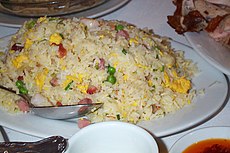Yangzhou fried rice
This article needs additional citations for verification. (September 2011) |
 | |
| Alternative names |
|
|---|---|
| Course | Entree |
| Place of origin | Yangzhou, China |
| Created by | Yi Bingshou (Qing dynasty) |
| Main ingredients | cooked rice; cha shao/char siu pork; cooked shrimp; scallions, chopped; egg yolks; peas; carrots |
| Variations | Fried rice |
| Yangzhou fried rice | |
|---|---|
| Chinese name | |
Hanyu Pinyin | Yángzhōu chǎofàn |
| Bopomofo | ㄧㄤˊ ㄓㄡ ㄔㄠˇ ㄈㄢˋ |
| Wade–Giles | Yang2-chou1 chʻao3-fan4 |
| Tongyong Pinyin | Yángjhou chǎo-fàn |
| IPA | [jǎŋ.ʈʂóʊ ʈʂʰàʊ.fân] |
| Yue: Cantonese | |
| Yale Romanization | Yèuhngjāu cháaufaahn |
| Jyutping | joeng4 zau1 caau2 faan6 |
| Southern Min | |
| Hokkien POJ | Iông-chiu chhá-pn̄g |
Yangzhou fried rice, also known by
Names
Yangzhou fried rice is a
The same dish is also known in the UK as "special fried rice" and in Australia and New Zealand as "combination fried rice". Less often, it is known in the United States as "house fried rice".
Ingredients
The difference between Yangzhou fried rice and ordinary fried rice is that Yangzhou style invariably includes a combination of proteins. Rather than using a single protein like shrimp or pork or chicken as the dominant ingredient in fried rice, Yangzhou uses a variety. Most commonly used is a combination of pork and shrimp; roasted or boiled chicken and duck are also found. Ordinarily, some of its staple items include:[1]
- Rice
- Egg
- Diced Chinese-style roast pork (char siu)
- Shrimp
- Chopped scallions, including the green end
- Vegetables such as Chinese broccoli (gai lan), carrots, peas, corn, and bamboo shoots
The peas may be a replacement or an addition for the green onions. Some recipes include Shaoxing wine. Some western Chinese restaurants also use soy sauce to flavor the rice, and add meat such as chicken.
History
Yangzhou fried rice was first popularized[]
In October 2015, as part of the 2,500th anniversary of the town of Yangzhou, an attempt was made in Yangzhou at beating the previous world record for fried rice set in 2014 by the Turkey culinary federation. The attempt, made by the World Association of Chinese Cuisine resulted in 4,192 kilograms (9,242 lb) of Yangzhou fried rice being produced by a team of 300 cooks.[3] The organizers initially planned to send the end product to five companies for consumption by their staff. However, about 150 kilograms (330 lb) of it ended up as pig swill, as it had been cooked for four hours and was felt unsuitable for human consumption. As per the organizers' intents, the rest was sent to local canteens.[4] However, due to a part of it being sent to feed animals, the world record attempt was disqualified, as a Guinness World Records spokesman said that it had become obvious that the dish was not fit for human consumption.[5]
See also
- List of Chinese dishes
- List of fried rice dishes
References
- ^ Dunlop, Fuchsia (20 May 2013). "Yangzhou Fried Rice". The Daily Meal. Tronc. Retrieved 29 April 2016.
- ^ Tracing the Source of Cantonese Cuisine, Wan Li Publishing, Hong Kong, 1988.
- ^ Yongqi, Hu (27 October 2015). "Yangzhou record for fried rice is revoked". China Daily. Retrieved 29 April 2016.
- ^ "Yangzhou stripped of fried rice record after waste scandal". People's Daily Online. Xinhua. 26 October 2015. Retrieved 29 April 2016.
- ^ Wang, Kevin (2015-10-26). "China: Record-breaking rice dish ends up as pig feed". CNN. Retrieved 2018-10-17.
